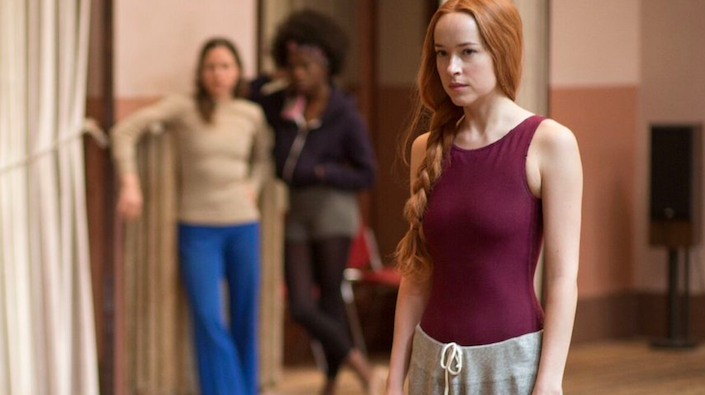Suspiria, Luca Guadagnino’s remake, or ‘cover version,’ as he calls it, of Dario Argento’s 1977 horror classic, is a hard pivot from both its source material and Guadagnino’s previous film, Call Me By Your Name. Whereas those films isolated their characters to watch the play of emotions in specific environs—CMBYN in a bourgeois summer home and Argento’s Suspiria in a witch-infested dance academy—the newest iteration of Suspiria has more all-encompassing ambitions. Nonetheless, the dense script is not enough to smother Guadagnino and his usual team’s masterful formalism. The clothes are beautiful; with a few notable exceptions, the people are beautiful; the dance scenes are chaotic, and the queer undertones are palpable.
Suspiria opens with Patricia (Chloё Grace-Moretz) frantically babbling about a coven to her psychiatrist. Drenched in sweat, she explains the hierarchical layers of the witches’ sanctum and the ways in which they uphold the facade of a dance company. As she paces from bookshelf to bookshelf across the office floor, the camera cuts between several vantage points on her increasingly-manic movement, affecting an unnerving sense of surveillance that is less preoccupied with monitoring than with intimidation. An “Appointment In Progress” sign flashes a menacing neon red outside the office door. The psychiatrist, a stodgy academic type played by Tilda Swinton in prosthetics, is concerned, but ultimately dismisses her. Immediately, Guadagnino and screenwriter David Kajganich introduce one of Suspiria’s key themes: The manifold power dynamics of suppression and repression.
The image of a ‘hysterical’ woman pleading desperately with an indifferent authority figure is a loaded signifier in 2018, and the script revives this motif in less than subtle ways throughout the film. The scope of Suspiria’s injunction is expanded, however, when Susie (Dakota Johnson), a Mennonite from Ohio, arrives at the aforementioned dance studio located immediately west of the Berlin wall.
In Kajganich’s script, however, the signification of the Berlin Wall is insufficient for his historical revisionist ambitions. The film promptly reveals Patricia’s involvement in the Red Army Faction (RAF), a militant leftist group that reached international fame in 1977, the year in which Suspiria is set, with the events of the German Autumn.
This much information would be cumbersome to disclose in any film, but Suspiria suffers from a particularly-clumsy unspooling of its complicated historical backdrop. Tropey context-giving clues like radio excerpts and political graffiti alert viewers that context is essential to the narrative, but they fail to consistently connect the plot beyond frustratingly broad strokes. Guadagnino and Kajganich are clearly stressing the necessity of violence in social upheaval, but the relevance of specific historical events is lost in the film’s dedication to carnage.
Of course, when Suspiria does catharsis, it does it right. In the moments it opts to let the plot step aside, it delivers gut-wrenching violence with a painterly precision. The film’s climax, in particular, unleashes the neon red coloured carnage that the witches are no longer able to suppress with brilliantly choreographed chaos.
Though the script could have benefitted from a firmer hand in the editing process, the production is executed masterfully. Guadagnino’s editor Walter Fasano finds himself a far cry from the languid rhythm of CMBYN, working instead in the vein of another 1970s horror classic, Don’t Look Now, to concoct a claustrophobic sense of spatial and temporal unity. The film’s frantic editing and distribution of information threaten to suffocate the characters, despite Suspiria’s extended runtime, but Johnson and Swinton are fantastic nonetheless, as neither character ends up close to where they started. As always, with Guadagnino and his costume designer Giulia Piersanti, the clothes are ravishing.
Suspiria has too much on its mind, and, though it is formally dazzling and strikingly ambitious, it never coalesces to form a consistent thesis. The ghosts of fascism, national guilt, motherhood and false motherhood, and the inevitability of violence in times of social instability all make potentially-interesting cameos over the film’s 152 minutes, but only its neon red carnage emerges with the vicious potency to which Guadagnino aspires.









